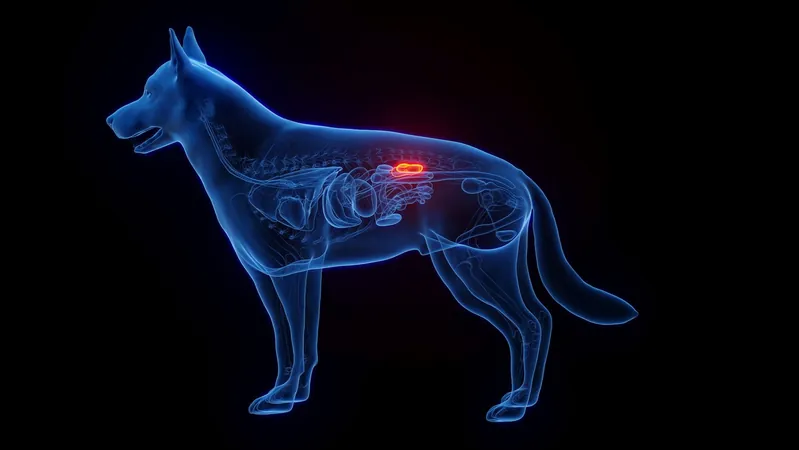
Unlocking Early Detection: How Urine Albumin-to-Creatinine Ratio is Revolutionizing Chronic Kidney Disease Diagnosis in Dogs
2025-01-22
Author: Arjun
The Importance of Early Detection in Chronic Kidney Disease
Chronic kidney disease (CKD) poses a serious threat to our canine companions, especially as they grow older. This progressive condition can lead to life-threatening complications, including anemia, kidney failure, and other associated health issues. Yet, the key to prolonging the lives and enhancing the well-being of dogs suffering from CKD lies in early detection.
Urine Albumin-to-Creatinine Ratio: A Game-Changing Biomarker
Recent advancements in veterinary diagnostics are focusing on the urine albumin-to-creatinine ratio (UAC), a crucial biomarker that provides a game-changing opportunity for early diagnosis of CKD. Unlike traditional blood tests that may reveal kidney dysfunction only after significant damage has occurred, UAC allows veterinarians to identify problems in the early stages—before dogs exhibit visible symptoms or deteriorating blood test results.
Significant Study Findings
The UAC is particularly valuable because an elevated ratio indicates kidney damage in both dogs and humans. In a significant study published in the Journal of Veterinary Sciences, researchers evaluated UAC in 221 dogs, comparing 99 healthy canines with 122 diagnosed with CKD. According to the study's findings, dogs with early-stage CKD presented notably elevated UAC values when compared to healthy counterparts, indicating that this test should be a staple in vet clinics.
Understanding the 'Grey Zone'
One groundbreaking aspect of this research is the establishment of a "grey zone" when interpreting UAC values. This threshold, ranging between 19.20 mg/g and the upper limit of normal (64.20 mg/g), identifies a spectrum where kidney dysfunction might be present but not immediately evident. This nuanced approach means that at-risk dogs can receive earlier intervention, significantly improving prognoses and quality of life.
Diagnostic Accuracy and Considerations
Furthermore, while the UAC has shown an impressive diagnostic accuracy with an area under the curve of 0.817, its sensitivity and specificity remain at 72% and 71% respectively. Therefore, it's essential to consider multiple biomarkers alongside UAC for a more comprehensive analysis.
Implications for Veterinary Care
Similar to trends observed in human medicine, where the albumin-to-creatinine ratio plays a critical role in kidney health assessments, the implications for dogs are profound. Monitoring UAC in canines carries the potential not only to track disease progression but also to shape treatment plans—offering a holistic approach to veterinary care that prioritizes early interventions.
Conclusion
In summary, the urine albumin-to-creatinine ratio stands out as a pivotal advancement in the early detection of CKD in dogs. By harnessing this biomarker alongside other diagnostic tools, veterinarians can better identify at-risk dogs, enhance treatment outcomes, and ultimately extend the lives of beloved pets. As this field continues to evolve, owners should remain vigilant and proactive about their dogs’ kidney health, seeking out the most current diagnostic methods to ensure a longer, healthier life for their furry friends.
Stay Tuned for More Insights
Stay tuned for more insights into the groundbreaking advancements in veterinary medicine, and how new diagnostic tools can save lives!

 Brasil (PT)
Brasil (PT)
 Canada (EN)
Canada (EN)
 Chile (ES)
Chile (ES)
 Česko (CS)
Česko (CS)
 대한민국 (KO)
대한민국 (KO)
 España (ES)
España (ES)
 France (FR)
France (FR)
 Hong Kong (EN)
Hong Kong (EN)
 Italia (IT)
Italia (IT)
 日本 (JA)
日本 (JA)
 Magyarország (HU)
Magyarország (HU)
 Norge (NO)
Norge (NO)
 Polska (PL)
Polska (PL)
 Schweiz (DE)
Schweiz (DE)
 Singapore (EN)
Singapore (EN)
 Sverige (SV)
Sverige (SV)
 Suomi (FI)
Suomi (FI)
 Türkiye (TR)
Türkiye (TR)
 الإمارات العربية المتحدة (AR)
الإمارات العربية المتحدة (AR)